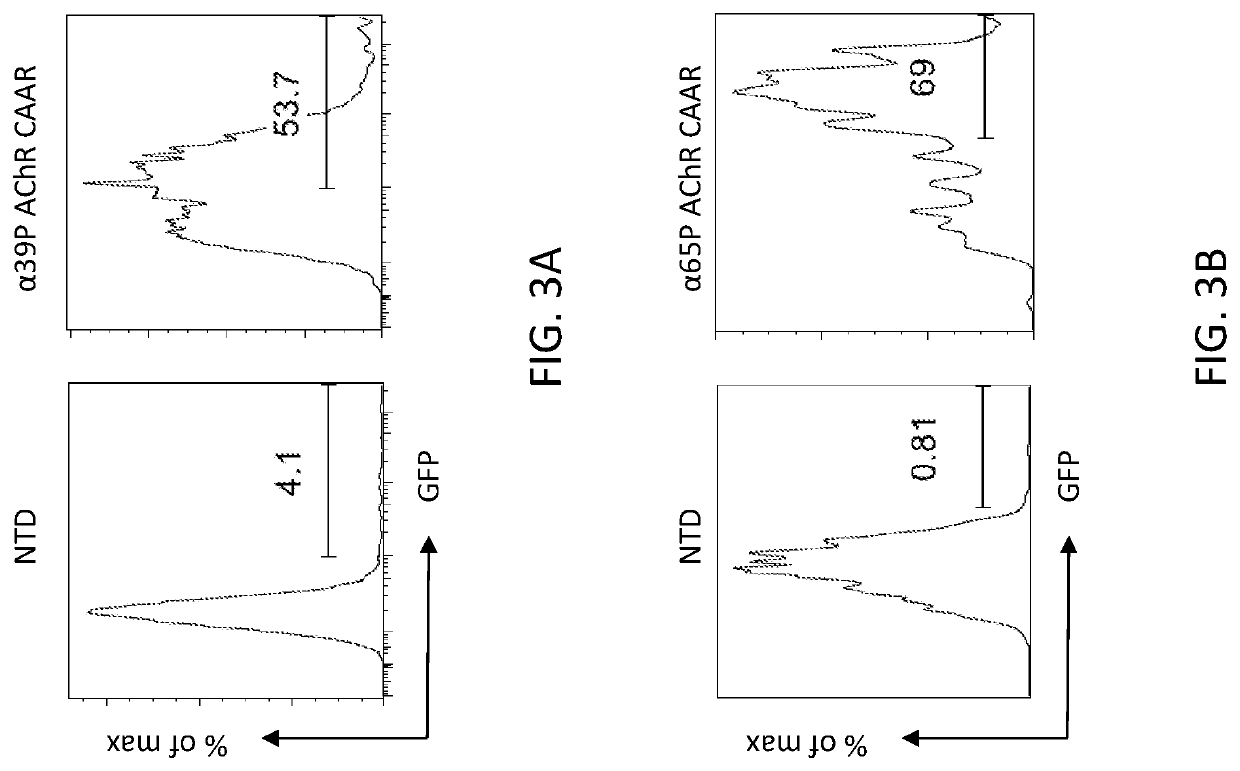Compositions and methods of acetylcholine receptor chimeric autoantibody receptor cells
- Summary
- Abstract
- Description
- Claims
- Application Information
AI Technical Summary
Benefits of technology
Problems solved by technology
Method used
Image
Examples
experimental examples
[0229]The invention is further described in detail by reference to the following experimental examples. These examples are provided for purposes of illustration only, and are not intended to be limiting unless otherwise specified. Thus, the invention should in no way be construed as being limited to the following examples, but rather, should be construed to encompass any and all variations which become evident as a result of the teaching provided herein.
[0230]Without further description, it is believed that one of ordinary skill in the art can, using the preceding description and the following illustrative examples, make and utilize the compounds of the present invention and practice the claimed methods. The following working examples therefore, specifically point out the preferred embodiments of the present invention, and are not to be construed as limiting in any way the remainder of the disclosure.
[0231]The Materials and Methods used in the performance of the experiments disclose...
example 1
α65P AChR CAART Cells
[0237]It is known in the art that autoantibodies from MG patients destroy AChR clusters and the NMJ. The anti-AChR antibodies interfere with AChR clusters. The AChR is a multisubunit structure. Pathogenic autoantibodies primarily target a defined region in the amino-terminal domain of the alpha subunit called the main immunogenic region (MIR).
[0238]FIG. 1 is a schematic of some of the CAARs of the invention, whose extracellular domain (ECD) comprises a segmental mimic of the Main Immunogenic Region (MIR) of the alpha subunit of the AChR, the major target of autoantibodies in MG, followed by a CD8 hinge domain, CD8 transmembrane domain (TMD), and tandem cytoplasmic signaling domains 4-1BB and CD3ζ (BBZ). α65P incorporates an additional EC1 domain sequence in comparison to α39P.
[0239]As illustrated in FIGS. 2A-2B, the α39P and α65P AChR CAARs were expressed on the surface of Jurkat and T cells, as indicated by staining with anti-AChR alpha subunit monoclonal antib...
example 2
α65P AChR CAART Killing Assays
[0243]α39P AChR-CAART and α65P AChR-CAART cells killed mAb 35 hybridoma cells and Nalm6 195 cells, but only α65P AChR-CAART cells can kill Nalm6 192 cells, in a luciferase-based killing assay, as shown in FIG. 6. The luciferase-based killing assay was conducted as follows T cells (NTD, α39P, and α65P) were co-incubated for 15-24 h with each target cells (mAb 35 hybridoma cells, Nalm6 192, and Nalm6 195) at 10:1 E:T ratio. % of Specific lysis=[(test cell death−spontaneous cell death) / (maximum cell death−spontaneous cell death)]*100. Spontaneous cell death: media only without T cells. Maximum cell death: treat 1:1 ratio with 10% SDS before detection.
PUM
| Property | Measurement | Unit |
|---|---|---|
| Fraction | aaaaa | aaaaa |
| Fraction | aaaaa | aaaaa |
| Fraction | aaaaa | aaaaa |
Abstract
Description
Claims
Application Information
 Login to View More
Login to View More - R&D Engineer
- R&D Manager
- IP Professional
- Industry Leading Data Capabilities
- Powerful AI technology
- Patent DNA Extraction
Browse by: Latest US Patents, China's latest patents, Technical Efficacy Thesaurus, Application Domain, Technology Topic, Popular Technical Reports.
© 2024 PatSnap. All rights reserved.Legal|Privacy policy|Modern Slavery Act Transparency Statement|Sitemap|About US| Contact US: help@patsnap.com










